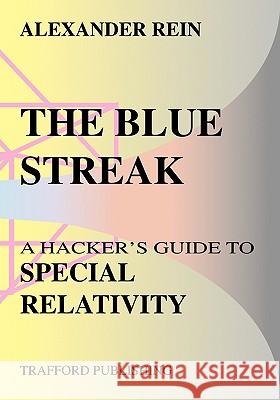The Blue Streak: A Hacker's Guide to Special Relativity » książka
The Blue Streak: A Hacker's Guide to Special Relativity
ISBN-13: 9781412001533 / Angielski / Miękka / 2003 / 272 str.
The hacker's approach to Special Relativity grew out of an attempt to demystify the puzzling features of the theory to intelligent but intuition-blocked lay persons by a strategy aimed at this particular handicap: The insufficiently understood basic concepts, the most obstinate stumbling blocks, are explained at length first. The four-dimensional cornerstone of the theory, the all-important Invariant, is presented as a geometric structure analogous to the Diagonal of a box-like Frame of Reference to which Time is subsequently added as the Fourth Dimension. The exposition of the theory of Special Relativity is primarily intuition-oriented while remaining also geometrically conceptualized and mathematically developed. It is built up from scratch around First Principles starting out with our primitive notions of Space, Time and Motion which are then continually updated and refined. The conceptual tools and terminology for investigating Linear Motion at Uniform Velocity are provided in a step-by-step fashion and always visualized by suitable illustrations. The Spacetime "terrain" (curved but not spherical) and its "domains" (Past, Present and Future) are defined, mapped and explained. The standard topics of Special Relativity are individually elaborated in the already introduced step-by-step fashion and its mathematical results, the equations, are not just displayed in print as usually done in undergraduate textbooks but are actually derived from familiar situations using only elementary algebra, the simplest possible math for the task. These derivations are additionally written out fully in longhand for the benefit of those still inexperienced or whose math has all gone to rust. The Theoryof Relativity is covered in sufficient detail to make this book an optional supplement in a college-level physics course. It can also serve as a source of information and insight in high-school and adult science clubs but, above all, it was meant to be a self-study manual, a virtual class room at home, a do-it-yourself tutoring aid.
Besides standard fare, two speculative topics are included: (1) a "Faster than Light" chapter dealing with its chief reputed consequence, the reversal of Time Arrow once the travel speed has "crashed" the "Light Barrier," and (2) a tentative description of a very-very fast moving object caught by our wide-open eyes or by a super-fast shutter speed camera.
The book and its intended readership are described in the Preface. Basic concepts and a brief historical background of the theory are given in the Introduction. In Chapters I-XV, you'll find the main topics and in the Postscript, there are additional comments pertinent to, but reaching above and beyond, the contents of this book.











